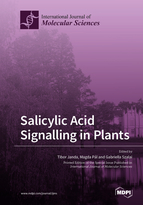Salicylic Acid Signalling in Plants
A special issue of International Journal of Molecular Sciences (ISSN 1422-0067). This special issue belongs to the section "Molecular Plant Sciences".
Deadline for manuscript submissions: closed (31 October 2019) | Viewed by 78710
Special Issue Editors
Interests: abiotic stress; acclimation; oxidative stress; polyamines; plant stress physiology; photosynthesis; salicylic acid; signalling
Special Issues, Collections and Topics in MDPI journals
Interests: abiotic stress; acclimation; heavy metal stress; oxidative stress; polyamines; plant stress physiology; salicylic acid; signalling
Special Issues, Collections and Topics in MDPI journals
Interests: abiotic stress; acclimation; analytical chemistry; oxidative stress; polyamines; plant stress physiology; salicylic acid; signalling
Special Issue Information
Dear Colleagues,
Salicylic acid (SA) is ubiquitously distributed in the whole plant kingdom. The basal level of SA differs widely among species. It is generally present either in the free state or in the form of glycosylated, methylated, glucose-ester, or amino acid conjugates. In plants, SA can be synthesized via two distinct and compartmentalized enzymatic pathways both requiring the primary metabolite chorismate. L-phenylalanine, derived from chorismate, can be converted into SA via the precursors free benzoic acid, benzoyl glucose, or ortho-hydroxy-cinnamic acid, depending on the plant species. Chorismate can also be converted into SA via isochorismate. Several physiological processes in which SA may play a role have reported, including seed germination, growth regulation, flower induction, thermogenesis, and, especially, the regulation of plant responses under biotic or abiotic stress conditions. SA may be involved in different signalling processes. For example, various hormones involved in plant defence mechanisms cross talk with SA, and both negative and positive interactions have been reported. SA signalling also leads to the reprogramming of gene expression and protein synthesis. It may affect the antioxidative metabolism, and it modulates cellular redox homeostasis. Although the therapeutic effect of SA in humans has been well studied for about 200 years, its role in plants has only been recognized in recent decades, and the full picture is still not clear. In spite of the extensive work on SA-related processes, the exact mode of action is poorly understood.
Papers submitted to this Special Issue must report high novelty results and/or new models on the mode of action of SA in plants. The molecular mechanism(s) of SA-related signalling processes, new results of the synthesis of SA, and the role of other related molecules (precursors, conjugated forms, etc.) are also interesting. Research articles and review papers are also welcome.
Prof. Dr. Tibor Janda
Dr. Magda Pál
Dr. Gabriella Szalai
Guest Editors
Manuscript Submission Information
Manuscripts should be submitted online at www.mdpi.com by registering and logging in to this website. Once you are registered, click here to go to the submission form. Manuscripts can be submitted until the deadline. All submissions that pass pre-check are peer-reviewed. Accepted papers will be published continuously in the journal (as soon as accepted) and will be listed together on the special issue website. Research articles, review articles as well as short communications are invited. For planned papers, a title and short abstract (about 100 words) can be sent to the Editorial Office for announcement on this website.
Submitted manuscripts should not have been published previously, nor be under consideration for publication elsewhere (except conference proceedings papers). All manuscripts are thoroughly refereed through a single-blind peer-review process. A guide for authors and other relevant information for submission of manuscripts is available on the Instructions for Authors page. International Journal of Molecular Sciences is an international peer-reviewed open access semimonthly journal published by MDPI.
Please visit the Instructions for Authors page before submitting a manuscript. There is an Article Processing Charge (APC) for publication in this open access journal. For details about the APC please see here. Submitted papers should be well formatted and use good English. Authors may use MDPI's English editing service prior to publication or during author revisions.
Keywords
- acclimation
- biosynthesis
- cross talk
- hormones
- phenolics
- plant growth and development
- plant stress
- salicylic acid
- signalling
Benefits of Publishing in a Special Issue
- Ease of navigation: Grouping papers by topic helps scholars navigate broad scope journals more efficiently.
- Greater discoverability: Special Issues support the reach and impact of scientific research. Articles in Special Issues are more discoverable and cited more frequently.
- Expansion of research network: Special Issues facilitate connections among authors, fostering scientific collaborations.
- External promotion: Articles in Special Issues are often promoted through the journal's social media, increasing their visibility.
- Reprint: MDPI Books provides the opportunity to republish successful Special Issues in book format, both online and in print.
Further information on MDPI's Special Issue policies can be found here.









